An Inside Look at Facebook's Headquarters
From the architecture to the incredible food to the family of foxes on campus, Facebook's headquarters is a one-of-a-kind workplace.
Bay Area tech companies are known for sprawling campuses and employee perks largely unheard of in other industries, but Facebook’s Menlo Park campus—located at 1 Hacker Way— is a truly self-contained microcosm.
Occupying over 250 acres on the edge of the San Francisco Bay, the 30-building campus feels more like a town than an office—although Facebook shuns the “town” label. The campus is split into four sections and is occupied by 10,000 employees; however, this number is projected to grow to 30,000 over the next 10 years, facilitating the need for a further expansion (more on that later!).
While Facebook shuttered its offices for over a year due to COVID-19, the social media giant began reopening its campus on May 10. However, with just 10% of the workforce returning onsite, Facebook’s free food and shuttle service won’t resume just yet.
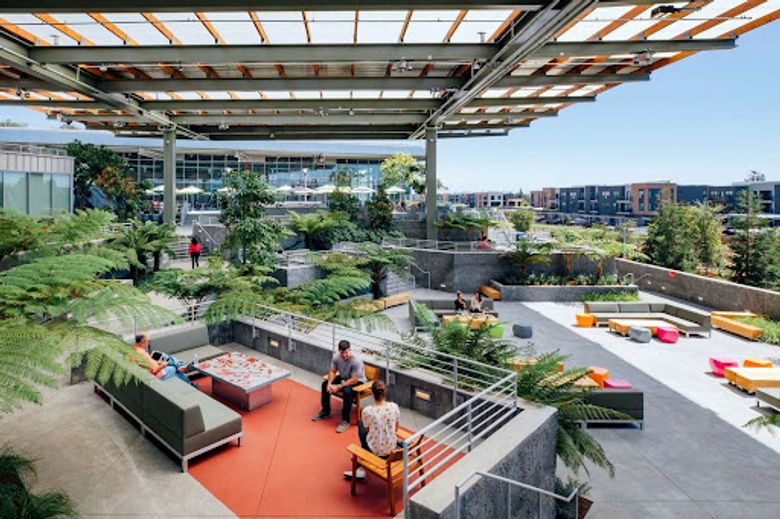
Photo credit: ArchDaily
An architectural edge
Despite the campus’s architectural pedigree—its two main buildings, MPK20 and MPK21, were designed by renowned Canadian architect Frank Gehry—Facebook’s headquarters are designed to embody its scrappy startup culture.
At the time of completion, MPK20 was the world’s largest open-plan office at 430,000 square feet. Picture this: a vast warehouse-like space with a 24-foot ceiling, large enough for up to 2,800 employees. The space is interspersed with a series of smaller structures such as conference rooms, floating workspaces, restaurants, and cafes—giving it the feel of an upscale indoor village.
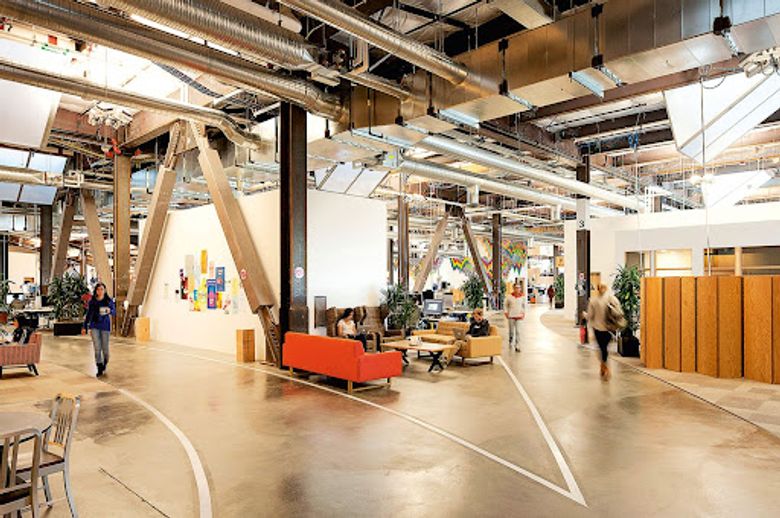
Photo credit: Arquitectura Viva
Zuckerberg revealed in a 2015 post on Facebook that the goal of MPK20 was to create the perfect space for engineering teams to work together and bounce ideas off each other. However, teams are not cloistered in separate areas. In fact, an employee on Facebook’s Oculus VR team may well find themselves sharing a workspace with someone from the Whatsapp team, for example.
Meandering walkways are designed to encourage employees to perambulate widely, based on the idea that revolutionary ideas germinate from chance encounters rather than sticking to a designated workspace.

Photo credit: ArchDaily
Employees are encouraged to hack their spaces, be it by painting their desk or moving furniture around. There’s even an old closet that was converted into an arcade, complete with VR games, old-school classic arcade games like Dance Dance Revolution.
“We want to make sure there is an element of flow and movement in the building that is conducive to allowing people to do the very best work of their careers.” - Janelle Gale, VP of Human Resources at Facebook.

Photo credit: Arquitectura Viva
Thanks to the building’s minimalist, stripped-back approach, the architects reduced construction time to a minimum, allowing the building to go from drawing board to completion in just three years.
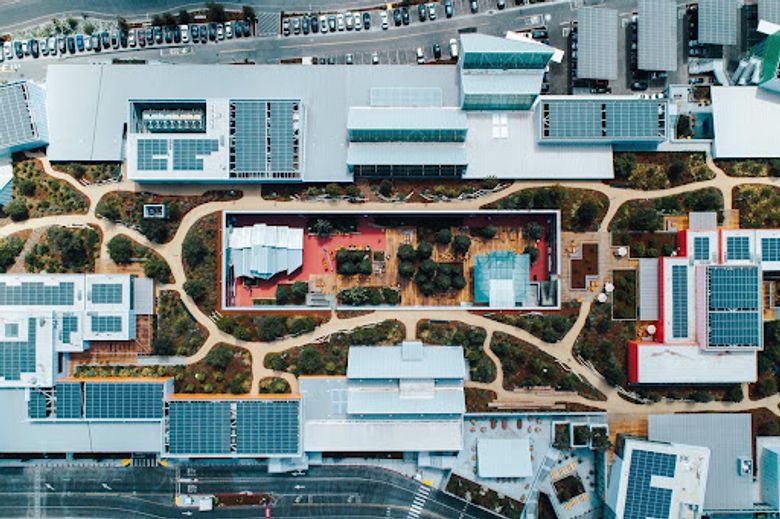
Photo credit: ArchDaily
Despite enlisting one of the most well-known architects in the world, the interiors exhibit considerable chaos.
Architectural critic Christopher Hawthorne described the workspace as “a dense view of unpainted steel beams alongside cords and wires running from the ceiling, with the heads of employees half-hidden behind giant monitors.”
In public comments about the building, Zuckerberg elaborated on the design ethos “It’s pretty simple and it isn’t fancy, but that’s on purpose. We want our space to feel like a work in progress. When you enter our buildings, we want you to feel how much there is left to be done in our mission to connect the world.”
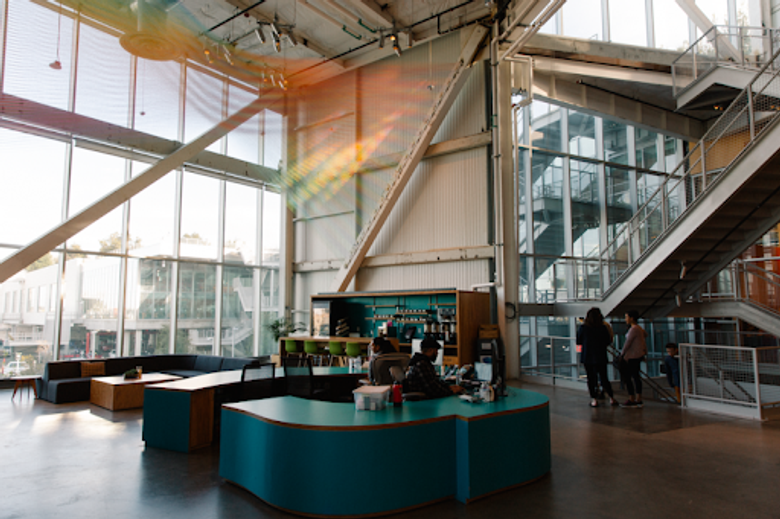
Photo credit: Built in SF
Shortly after, Facebook expanded again with MPK21, which sits on a former occupied industrial site.
Both buildings—MPK20 and MPK21—are conjoined by a rooftop amphitheater-style courtyard called The Bowl because of its sunken design, where staggered seating levels are interspersed with tropical plants. At the center of each outdoor table sits a built-in gas fireplace, with flames that can be turned on and off at will.
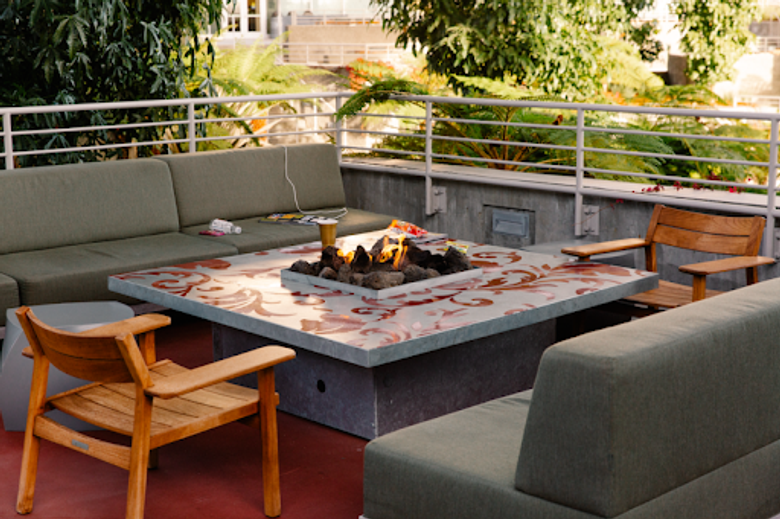
Photo credit: Built in SF
Unfortunately for the public, Facebook is surrounded by walls that separate the Menlo Park campus from the Baylands.
Incredible landscaping
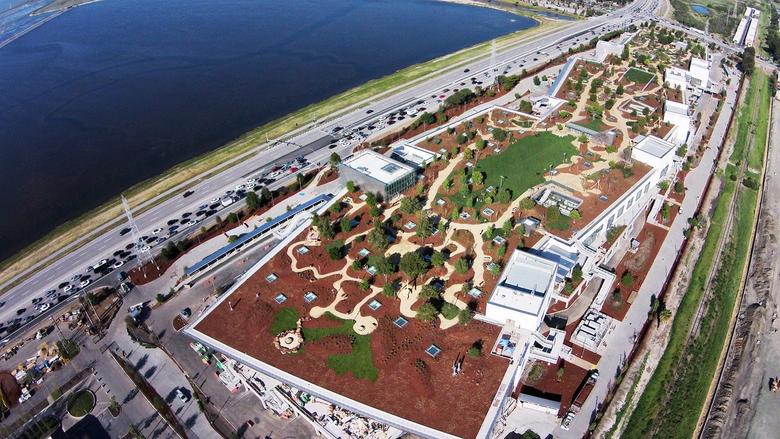
Photo credit: Wired
Speaking of rooftops, the horticulture is undoubtedly the campus’s most stunning feature.
A nine-acre rooftop garden covers the entire campus, with manicured shrubbery and mature trees that surround the building. The garden contributes to the building’s LEED Gold Certified status by insulating the building naturally, which greatly reduces heating and cooling demands. An irregular, sawtooth roof and abundance of glass panels are designed to admit natural sunlight.
BOX: More on sustainability at Facebook
- A reclaimed water system filters and recycles water in MPK21, which will save 17 million gallons of water annually, according to Facebook
- The roof has 1.4 MW of photovoltaic panels, which will generate nearly 2 million kwH of electricity annually (that’s enough to power 70,000 homes for a day)
- The windows feature bird-friendly glazing, which allows for clear views and natural daylighting while preventing birds from crashing into the glass.
- MPK21 is certified LEED Platinum by the US Green Building Council, earning 88/110 points, the highest of any Facebook project across global data centers and office
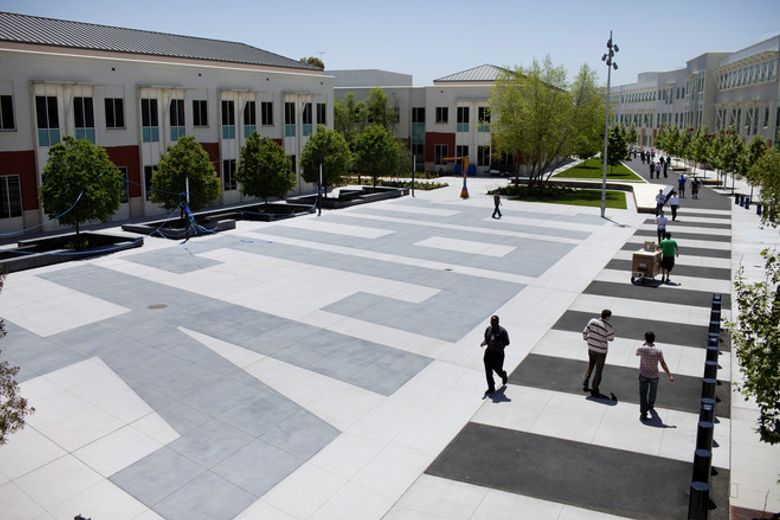
Photo credit: WSJ
A central courtyard in the middle of the campus from the “town square,” with restaurants, amenities, and 40-foot-tall redwood trees. The town square is called Hacker Square, where the word ‘hack’ is spelled out in paving stones so big you can see it from space. Core circulation runs through the center of the building like a main street, providing access to five restaurants and 15 art installations by Facebook’s Artists in Residence program.
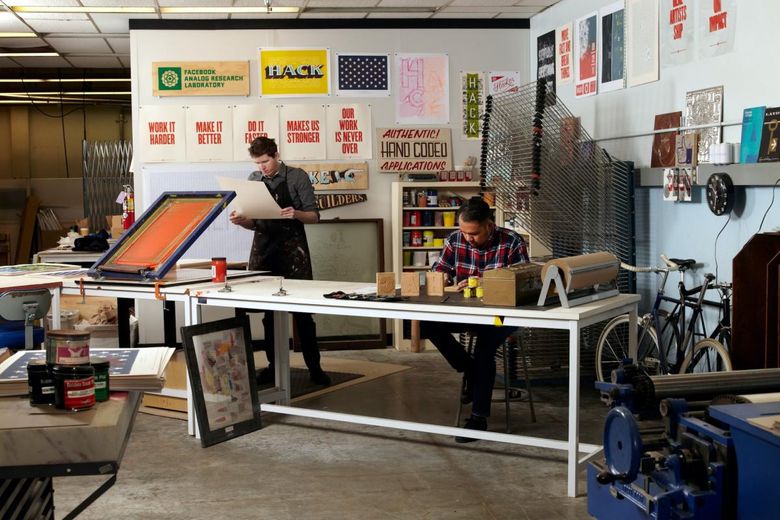
Photo credit: Office of Ben Barry
In fact, there’s even a dedicated art studio called the Analog Research Lab, which started in 2010 when two Facebook employees took over an unused warehouse space in one of the company’s new buildings. This is where Facebook employees create screen-printed posters bearing slogans the company has become famous for, including “What would you do if you weren’t afraid?” and “Move fast and break things,” said to be Zuckerberg’s personal motto as a celebration of the hacker mindset. The Facebook founder later revised the motto to “Move fast with stable infrastructure” after the social media giant was embroiled in a series of controversies.
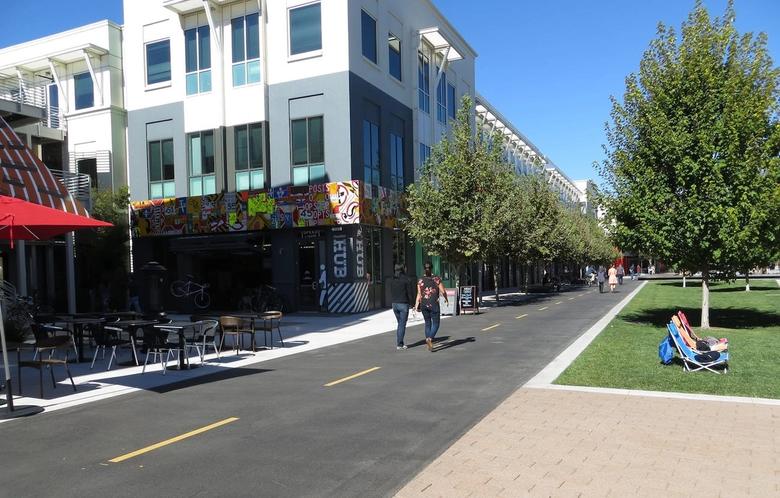
Photo credit: Business Insider
While the entire campus feels nothing like an office, the main street is a place where you can abandon all pretense of being at work. Get this: Facebook hired consultants who helped design Disneyland to trick out main street, which is inspired by Palo Alto’s actual Main Street.
The central road of the campus is lined with employee benefits and services, including a coffee shop, a barbershop, and a Mexican restaurant originally from Palo Alto, which the Facebook founders loved so much they convinced the owners to open an additional outpost.
“Everything is free or nearly free, and everyone you pass is well educated, well paid, well fed and very smart,” reporter Luke Stengel wrote for the Silicon Valley Business Journal.
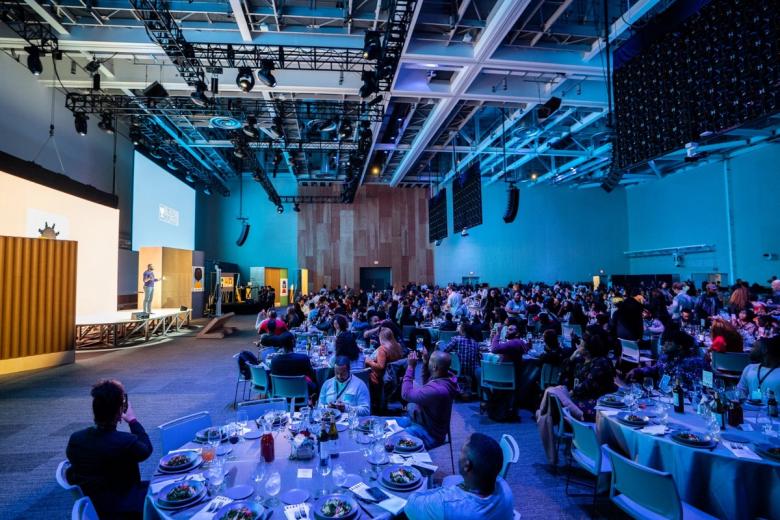
Photo credit: Lightswitch
At the heart of the campus is a 20,000 square foot events center with 2,000 seats. Employees refer to it as ‘The Museum’ because each room configuration is named after a famous art museum (Broad de Young, Hermitage, LACMA, Frick Collection).
Unequaled employee perks
Facebook’s much vaunted employee benefits are evident on Main Street. In addition to eateries, there are onsite dry cleaning services, a bike repair shop, and a health center providing medical and dental care. Employees can visit the health center for their annual physical exam, routine dental care, and even minor surgeries.
Uwe Muegge, Facebook’s head of terminology, wrote in a LinkedIn post that he has used the Wellness Center for everything from “getting a hamstring injury diagnosed by a sports medicine physician and having the injury treated by a physical therapist and an acupuncturist” to “getting prescription glasses.”
When it comes to wellness, Facebook’s perks are unrivaled. Three gyms on Facebook HQ provide premiere fitness equipment, a functional training space, plus free stretch breaks and group exercise classes. If pumping iron isn’t your thing, Facebook supports other physical activities with a wellness reimbursement of up to $720 per year ($240 if you’re an intern), which reimburses the cost of an external gym membership, golf green fees, sports leagues, smart watches, weights, and more. You’ll still get the full amount even if you join Facebook mid-year. On top of that, the campus features a rock gym, sand volleyball court, and a FIFA-compliant soccer field.
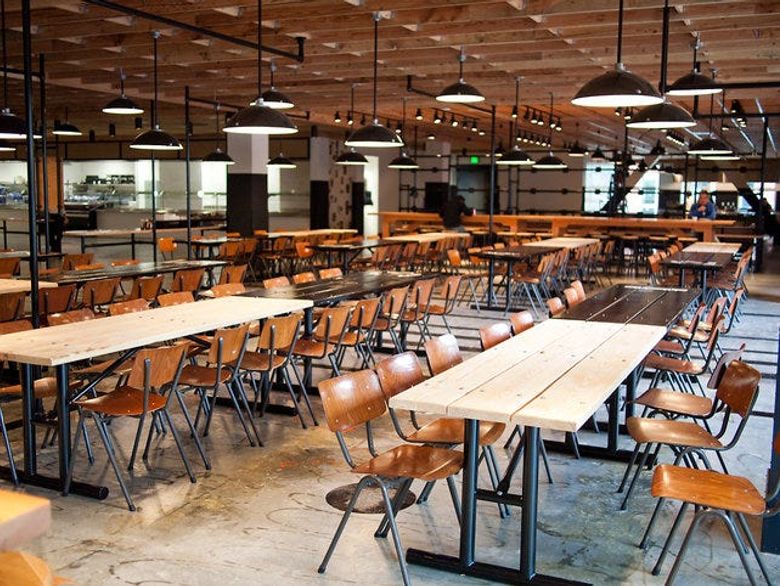
Photo credit: Business Insider
In terms of onsite perks, nothing beats free food. Facebook’s main cafeteria is the Epic Cafe, which serves three meals a day, five days a week, plus snacks. Every meal is different from the one before, offering a variety of world cuisines, including Mediterranean, Indian, Vietnamese.
In fact, there’s a running joke about the ‘Facebook 15,’ the inevitable weight gain in pounds that comes with such an abundance of free food. In fact, tech companies are often able to lure award-winning chefs because they are able to offer restaurant staff above-average pay and more conventional working hours than in the traditional restaurant business.
“Unsurprisingly, one of the first skills I learned in my first day on the job at Facebook was how to make a latte. And in the micro kitchens, you can froth any type of milk [...] to go with your espresso: whole, reduced-fat, non-fat, lactose-free, almond, soy, oats, hemp, you name it.” - Uwe Muegge, via LinkedIn
Much ado about bicycles
In a bid to encourage zero-emissions commuting, Facebook’s campus features numerous accommodations for cyclists. Employees can borrow a bike and helmet for on-campus commuting—a 2-mile bike lane spans the entire campus—and there is a roundabout exclusively for cyclists. Bike racks are a fixture on every floor of the office building, and every second Thursday of the month is Bike to Work Day, where there are organized group rides to campus upon arrival, and you can pick up free swag from the bike shop such as a repair kit, pump, or bell.
If you prefer four wheels instead of two, there’s valet parking and a free charging station for electric cars. Facebook also operates an extensive network (over 50 routes) of shuttle buses that serve the entire Bay Area. The buses are outfitted with reclining seats, onboard Wifi, and tables with power outlets.
Foxes!

Photo credit: Built in SF
Since 2013, a family of foxes has lived on the Facebook campus’s rooftop garden. Employees love sighting them out and about—so much so that they even created an internal group dedicated to the foxes on Workplace, their in-house communications platform, where people post about recent fox sightings, according to Business Insider.
Pictures of the foxes are shared on Instagram under the hashtag #FacebookFox. In fact, Facebook’s campus was designated as a wildlife habitat due to their presence. In order to keep them wild, employees are told not to feed or pet the foxes.
Further expansions
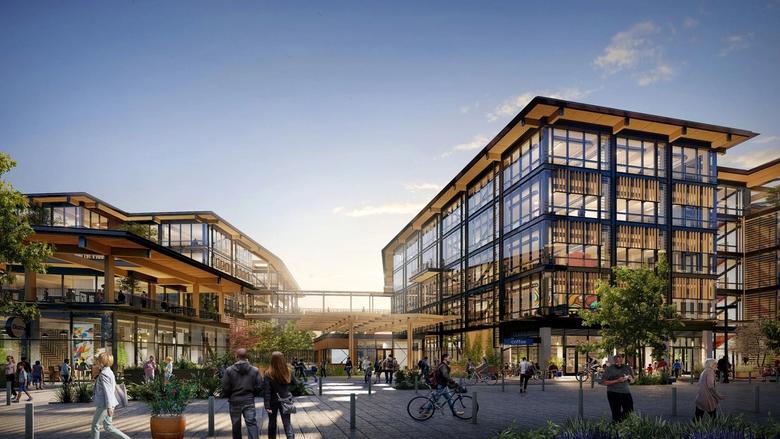
Photo credit: The Almanac
As if that weren’t enough, FB has plans to build a “village” near its HQ in Menlo Park. Willow Village, proposed in 2017, is a mixed-use project that connects the existing campus to the surrounding neighborhood.
The site will include a supermarket, a pharmacy, cafes, a 193-room hotel and a town square. Surrounding the site will be 1.25 million square feet of FB office space, and 1,729 apartments (these residential units will be open to the public).
The final verdict
With a market capitalization of $1.028 trillion, Facebook doesn’t coddle its employees out of a sense of charity. Everything from the building design to the amenities offered is designed to squeeze as much productivity as possible from their employees.
According to the Silicon Valley Business Journal, the HR team “tracks detailed metrics related to each perk, and measures their cost against the resulting level of employee productivity.”
“Facebook is not a place where people clock in at 9 and clock out at 5,” Luke Stengel writes. “There are very few errands you have to run during the day that you can’t run on campus.”
The information provided herein is for general informational purposes only and is not intended to provide tax, legal, or investment advice and should not be construed as an offer to sell, a solicitation of an offer to buy, or a recommendation of any security by Candor, its employees and affiliates, or any third-party. Any expressions of opinion or assumptions are for illustrative purposes only and are subject to change without notice. Past performance is not a guarantee of future results and the opinions presented herein should not be viewed as an indicator of future performance. Investing in securities involves risk. Loss of principal is possible.
Third-party data has been obtained from sources we believe to be reliable; however, its accuracy, completeness, or reliability cannot be guaranteed. Candor does not receive compensation to promote or discuss any particular Company; however, Candor, its employees and affiliates, and/or its clients may hold positions in securities of the Companies discussed.
